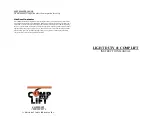
6
• Make sure welding area has a good,
solid, safe floor, preferably concrete or
masonry, not tiled, carpeted, or made of
any other flammable material.
• Protect flammable walls, ceilings, and
floors with heat resistant covers or
shields.
• Check welding area to make sure it is
free of sparks, glowing metal or slag, and
flames before leaving the welding area.
FUME HAZARDS
WARNING
FUMES, GASSES, AND VAPORS CAN
CAUSE DISCOMFORT, ILLNESS, AND
DEATH!
To reduce the risk of discomfort, ill-
ness, or death, read, understand, and follow
the following safety instructions. In addition,
make certain that anyone else that uses this
welding equipment or is a bystander in the
welding area, understands and follows these
safety instructions as well.
• Do not weld in an area until it is checked
for adequate ventilation as described in
ANSI standard #Z49.1. If ventilation is not
adequate to exchange all fumes and
gasses generated during the welding
process with fresh air, do not weld unless
you (the welder) and all bystanders are
wearing air-supplied respirators.
• Do not heat metals coated with, or that
contain, materials that produce toxic
fumes (such as galvanized steel), unless
the coating is removed. Make certain the
area is well ventilated, and the operator
and all bystanders are wearing air-sup-
plied respirators.
• Do not weld, cut, or heat lead, zinc, cad-
mium, mercury, beryllium, or similar met-
als without seeking professional advice
and inspection of the ventilation of the
welding area. These metals produce
EXTREMELY TOXIC fumes which can
cause discomfort, illness, and death.
• Do not weld or cut in areas that are near
chlorinated solvents. Vapors from chlori-
nated hydrocarbons, such as trichloroeth-
ylene and perchloroethylene, can be
decomposed by the heat of an electric
arc or its ultraviolet radiation. These
actions can cause PHOSGENE, a HIGH-
LY TOXIC gas to form, along with other
lung and eye-irritating gasses. Do not
weld or cut where these solvent vapors
can be drawn into the work area or where
the ultraviolet radiation can penetrate to
areas containing even very small
amounts of these vapors.
• Do not weld in a confined area unless it
is being ventilated or the operator (and
anyone else in the area) is wearing an
air-supplied respirator.
• Stop welding if you develop momentary
eye, nose, or throat irritation as this indi-
cates inadequate ventilation. Stop work
and take necessary steps to improve
ventilation in the welding area. Do not
resume welding if physical discomfort
persists.
Содержание MMIG125
Страница 8: ......
Страница 23: ......
Страница 24: ...24 TABLE 5 TROUBLESHOOTING ...
Страница 25: ...25 MMIG125 WIRING DIAGRAM ...
Страница 26: ......
Страница 27: ...27 1 888 287 6981 ...







































